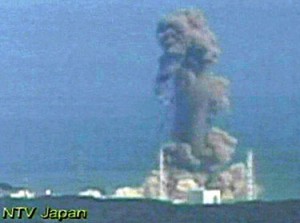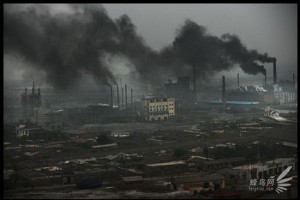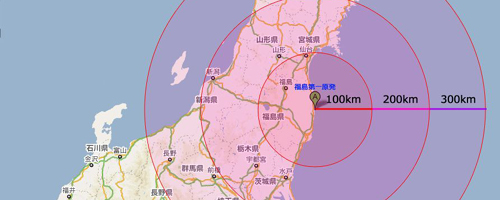 Just as Japanese officials declared the crippled Fukushima Daiichi Nuclear Power plant in “cold shutdown” an undercover reporter who had snuck into the plant as a temporary worker revealed the actual inner workings and FUBAR situation of the plant to the Foreign Correspondents Club of Japan.
Just as Japanese officials declared the crippled Fukushima Daiichi Nuclear Power plant in “cold shutdown” an undercover reporter who had snuck into the plant as a temporary worker revealed the actual inner workings and FUBAR situation of the plant to the Foreign Correspondents Club of Japan.
nuclear power
AP has an excellent article up detailing the incestuous relationship between Tokyo Electric Power Company (TEPCO) and the government regulators that were supposed to be keeping a watchful eye on the industry.
First things first: Nuclear Power is a tricky issue. I don’t expect to solve it in a short article and some snarky comments. Nonetheless, it’s one of the key issues confronting countries around the world as their existing power stations age and (in many cases) as their demands for energy grow, especially in developing countries like China and India.
Second things second: It’s important to look at this issue (like any issue) logically and not with emotional knee-jerk reactions.
What I mean is this. If I show you this picture:
and ask whether cats are cuddly and cute or vicious killers who must be controlled, you’ll at least be conflicted.
If I show you THIS picture:
and ask whether cats are cuddly and cute or vicious killers who must be controlled, I know your answer.
If I ask you what you think of nuclear power after you’ve just seen this:
well…..
But what if I showed you
and asked you whether you want a few hundred more of these going up around the world in the next decade, or whether you would prefer some power stations which don’t use coal or oil or gas and which don’t emit greenhouse gases?
For further amusing and scary information on the way this kind of emotional manipulation can be used in surveys, I highly recommend this classic Yes Minister clip:
Moving on:
What are the advantages of nuclear power? Well, that’s easy, we’ve cited some of them above:
1. No greenhouse gas emissions, or other noxious substances which contribute to acid rain, smog and other air pollutant.
2. Doesn’t use traditional fossil fuels and we don’t seem to be in danger of running out of uranium any time soon.
3. Already commercially viable and practical, and indeed very efficient, for use on the scale of providing power to millions of homes and businesses.
1 & 2 are the advantages over traditional fossil fuel power stations. 3 is the advantage over renewable energy sources apart from hydro power. Naturally, if we could just rely on solar power and wind power for all our energy needs, we would do it. It can’t be done yet. For now, it’s a 2 horse race. Perhaps we’re talking a stop-gap measure for only 5-10 years, maybe we won’t have renewal energy on a practical scale until vicious war halves the population. But every year, more power stations must go up around the world to meet demand, and we’ve got to decide what we want them to be NOW, not in 10 years (or after Thunderdome).
What then are the disadvantages?
1. If a nuclear plant goes bad, it will contaminate the surrounding land beyond habitability forever (until cleaned up, if it can be cleaned up, which will take decades).
2. If a nuclear plant goes bad, it may release radioactive particles into the wind and water which spread far beyond the immediate area, making the health damage more than just a localized issue.
3. Nuclear energy may not produce air pollutants, but it does create noxious waste of another kind which must be stuck somewhere. The more nuclear energy used, the more waste produced and the more secure faraway places we must find to stash the radioactive waste.
4. Risk of uranium fuel sales being diverted into weapons manufacture, or at “best” a “dirty bomb”.
To counter this, one could say: these are all manageable risks. If you don’t mess up running your nuclear plant (and hundreds of such plants around the world, for decades, have run without melting down), 1 & 2 don’t matter. if you can successfully store and partially recycle your radioactive waste (which, so far, has been managed by all nuclear countries), 3 doesn’t matter. If you keep proper security, 4 doesn’t matter. The problems with fossil fuels, on the other hand, cannot be stopped. Fossil fuels will run out, and when you burn them they release tons of air pollutants.
The trouble with that argument is of course, that ignoring Chernobyl, partial meltdowns and major leaks have occurred in the United States, the United Kingdom and now Japan. Few countries are not subject to major earthquakes or floods or other disasters which can affect the safe operation of plants despite all the safety precautions. And now we’re talking about rolling more of the things out in an era of lowest-price-wins construction tendering, in developing countries who haven’t had 30 years of experience to iron out the teething problems, in countries where a $10,000 bribe to divert some uranium isn’t chickenfeed but instead enough money to set a family up for life.
My personal belief is that most if not all nuclear power accidents have occurred with old technology (even the Fukushima reactor at the center of the present crisis is a very old one built to lower safety precautions than are now in use, and which was already overdue to be decommissioned). Countries can safely use nuclear power as a stopgap for renewable energy, and must do so to buy time to get greenhouse gas emissions down, but they should heed the lessons of Fukushima about doing anything on the cheap or taking anything for granted, and if wealthier countries need to chip in a bit to ensure others do it properly and don’t leave nuclear power plants to be built by the President’s brother-in-law and staffed by men paid $1 a day, then they should realise it’s in their own collective self-interest, less a fallout cloud sweep across their borders.
But on the other side, I can see how this will only create a permanent and huge hoard of nuclear waste, to be stored effectively forever, a long-term problem to be managed long after greenhouse gases have been brought under control, and that my idealistic dream of countries acting responsibly in this day and age is overly optimistic, and that fossil fuel power plants are a necessary way of playing it safe, the lesser evil to avoid the catastrophe of nuclear meltdowns.
Or maybe we should just accept global warming is inevitable and plan for how to survive that, not how to shuffle deckchairs on the beach while the tide is rising?
Your thoughts, upon reaching the end of this lengthy post, would be appreciated.
We’ve been hearing on the news since the earthquake/tsunami/all around shitty time in Japan started. However, have you wondered why these explosions are happening? Well, I’ll attempt to explain it.
To break it down, fuel rods in a nuclear reactor are composed of zircoloid containing uranium dioxid The uranium used in nuclear power plants, uranium 235, is a highly charged, fissile element. When an element is fissile, it means it can sustain a fission chain reaction, so when the neutron (the tiny part of an atom that exists within the nucleus of said atom) touches another nucleus of uranium 235, a chain reaction occurs; causing energy release that can be harnessed via nuclear power plants. Now, as anyone who has ever broken a sweat by way of physical effort knows that energy release creates heat, thereby making these fuel rods, well, wicked hot.

Because these fission reactions can cause explosions, and to keep these rods from completely blowing up, the fission reaction is slowed down by control rods composed of boron, cadmium, and hafnium. These elements can absorb neutrons, slowing the collision of the nuclei, and diminishing the power of the uranium rods.
In fact, if they become hot enough, they can swell and crack, which would cause radioactive gases (caesium and iodine) to escape, which is bad news bears for everyone. So, a system had to be devised to keep these rods cool enough to; 1) not incinerate everyone in the area, 2) not melt a radioactive hole in the ground, and 3) not give everyone radiation poisoning.
And how do they do this? With water, glorious water – is there anything it can’t do? The Water is pumped into the reactor, which contains the insanely hot uranium rods, and is contained in a concrete housing. To give you an idea of how effective concrete can be in protecting us from radiation; it’s what is keeping the Chernobyl reactor sealed off after their disaster in 1986. Before you start to worry this will end up like Chernobyl, it’s not likely. The reactors in the Chernobyl plant were not surrounded by any remotely effective barrier, leaving everyone completely unprotected from any sort of accident. The Japanese know more, and are more careful than the people who ran the Chernobyl plant, so the risk is significantly lower. However, the potential danger of the situation should not be underestimated, and per the graphic I “borrowed” from MSNBC, who borrowed it from Reuters, it looks like even the concrete containment unit won’t be guaranteed to always be able to contain the melted uranium. There are several more things that have to happen for the situation to get to that point, but there’s a lot of chaos, a lot of danger, and a lot of unknowns at the moment.
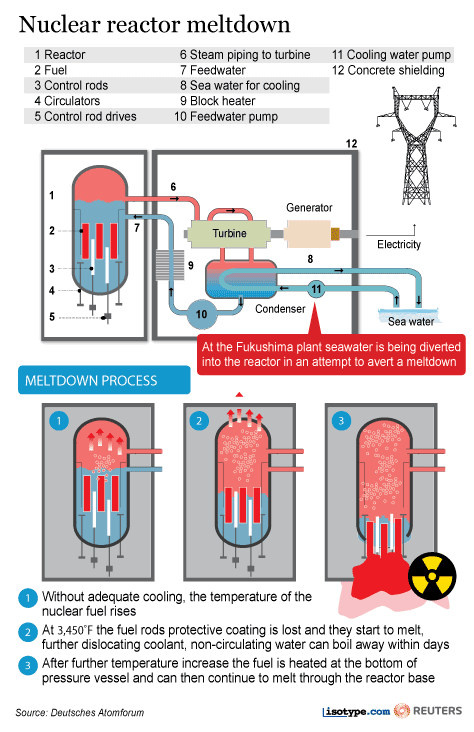
*ahem* So, the reactor has pumps for both the control rods and the circulators which, surprise surprise, circulates the water around the rods which enables them to cool more effectively than standing water. The heated water turns into steam in the reactor, which is then pumped out through the turbine to the condenser where the steam is converted to water once again. Lather, rinse, repeat.
Because of the earthquake, the pumps in the reactor moving the cooling water failed, thereby allowing the uranium rods to overheat and produce excessive hydrogen-containing steam. As the rods continue to get hotter due to the lack of circulating water, steam increases, as does the pressure inside the reactor. The pressure then makes it impossible to pump more water into the reactor. So, the engineers, with the intention of avoiding a meltdown, allowed some of the steam to vent out of the reactor and into the environment. The downside is the steam releases radioactive elements into the environment, hence the warnings to stay indoors and/or evacuate.
Now how does all this relate to hydrogen? When the zircoloid tubes containing the uranium dioxide heat up, they react with the cooling water to form hydrogen which builds up in there steam. As anyone who is familiar with the Hindenberg knows, Hydrogen is extremely explosive, so excessive pressure inside the reactor+ a teensy bit of hydrogen escaping the reactor = big explosion.
If the water levels continue to drop within the reactor, the uranium rods will overheat and melt down through the reactor. The good news? The melted uranium will stay inside the concrete containment unit, as happened at Three Mile Island.
Is there more? Absolutely. Can I fill you in on more? Probably not much more than this without a ton of research, and they don’t pay me enough for that. In fact, if anyone else notes any inaccuracies in this article, please point them out in the comments. I did my best to explain this correctly, but being that my background in this includes a little college-level physics, a nuclear engineer bff, and a general curiosity for the subject matter. There are a number of good resources on both Japan’s nuclear plants as well as nuclear power on the internet from actual nuclear scientists that should be able to add more information, should you wish to seek it out.
World Nuclear News is an industry newsletter which has quite a bit of interesting information, as well as frequent news updates regarding the situation in Japan. Interestingly enough, they’re also on facebook.
In addition, many news websites have good information in relation to the incident. BBC News, Reuters, MSNBC, and Kyodo News have been rather informative.
Note: I am working today until 4PM EST without access to a computer. So if you comment and I don’t respond, it’s not because I don’t care, it’s because I can’t see it before 4. Where’s that computer chip for my brain?
Where are all these nuclear power plants that have been the cause of so much speculation? Maybe in your back yard. A full list is available at Wikipedia.
The first map is courtesy of Argonne National Laboratory. It show the location of all plants active and inactive, well except the ones that government doesn’t want us to know about. Closed plants are still not the kinds of places you want to build playgrounds and swimming pools.
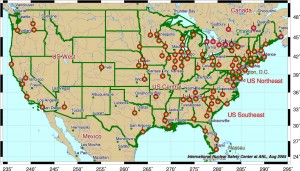
Next we have a nice map from world-nuclear.org. This one shows only plants that are up and running.

Many of the older reactors have been shut down as they become too expensive to maintain, obsolete or go past their permit date without an extension. The cluster of dots on many locations are to show the multiple reactors per location.
From world-nuclear.org:
The USA has 104 nuclear power reactors in 31 states, operated by 30 different power companies. In 2008, the country generated 4,119 billion kWh net of electricity, 49% of it from coal-fired plants, 22% from gas and 6% from hydro. Nuclear achieved a capacity factor of 91.1%, generating 805 billion kWh and accounting for almost 20% of total electricity generated in 2008. Total capacity is 1088 GWe, less than one-tenth of which is nuclear.



